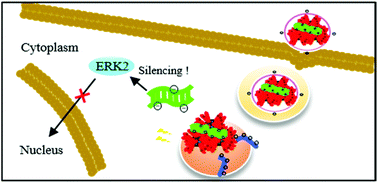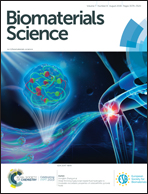A “self-accelerating endosomal escape” siRNA delivery nanosystem for significantly suppressing hyperplasia via blocking the ERK2 pathway†
Abstract
Small interfering RNA (siRNA)-based therapy is an emerging treatment to address serious cardiovascular disease. It is essential to construct highly efficient vehicles for therapeutic siRNA intracellular delivery. Extracellular signal-regulated kinase-2 (ERK2) siRNA (abbreviated as ERK2-siRNA) is known as a type of siRNA to selectively silence the expression of ERK2. Herein, a type of ternary delivery system characterized by an endosome-selective-self-accelerating-escape ability was designed and prepared for the purpose of inhibiting the migration of vascular smooth muscle cells (VSMCs) in vitro. This system was called ternary ERK2-siRNA complexes (abbreviated as TRCs-Aco), which were fabricated via sequential electrostatic self-assembly of a star-shaped cell-penetrating peptide based on polyhedral oligomeric silsesquioxane (POSS-(C-G-R8-G-W)16), ERK2-siRNA and a pH-sensitive anionic polymer of cis-aconitic anhydride grafted ε-poly(L-lysine). Importantly, TRCs-Aco could break down the obstacle of biocompatibility-silencing efficiency. In comparison with the parent binary siRNA complexes (abbreviated as BRCs), which are composed of POSS-(C-G-R8-G-W)16 and ERK2-siRNA, our designed TRCs-Aco revealed more excellent biocompatibility including hemocompatibility and cytocompatibility. Unexpectedly, TRCs-Aco exhibited stronger ERK2 silencing efficiency at the level of mRNA and protein, which was mainly due to its remarkable self-accelerating endosomal escape. Definitive evidence demonstrated that this ternary ERK2-siRNA delivery system significantly prevented the migration of VSMCs and decreased the dermal thickness in bleomycin-treated mice. In brief, this unique structured system could provide a valuable nanoplatform for highly efficient siRNA delivery in VSMCs, and it might hold great potential in guiding ERK2-siRNA-based proliferative disease therapy.



 Please wait while we load your content...
Please wait while we load your content...